|
|
Opening Up About Lab-Grown
As synthetic diamonds gain mainstream appeal, the debate over how the sector will evolve is back in the spotlight.
Jun 17, 2021 4:27 AM
By Avi Krawitz
|
|
|
RAPAPORT... Two philosophies have emerged regarding how the lab-grown market will develop.
The first sees synthetics in the same space as natural stones, graded according to carat size, cut, color and clarity, and priced at a discount to the equivalent natural diamond. That is how the market has evolved organically.

The second ideology is the one De Beers has touted in releasing its Lightbox line. It recognizes that synthetics have their place in the market, but maintains that they are inherently different from natural diamonds. Those taking this view say lab-grown products should be assessed via quality assurance rather than grading, and priced at a markup to what it costs to make them, disregarding the 4Cs.
The heart of the debate revolves around what a diamond is and what gives it value. The answers to those questions call for different selling propositions. Are synthetics simply a price-point product? Or are there branding opportunities that transcend price?
If a high-end brand such as Cartier decides to use lab-grown diamonds, as CEO Cyrille Vigneron hinted in a May interview with Forbes, will consumers be buying the diamond or the Cartier design? If one assumes the latter, it is unlikely that Cartier will lower its price points; that would reduce the mystique and rarity of its brand. Using synthetics would instead serve only to improve Cartier’s margins. But then the question becomes whether the value of the piece will drop as demand for lab-grown matures and supply increases.
These are considerations that jewelers entering the lab-grown space need to explore. For now, they are justifying the move on environmental grounds, as Pandora recently did when it announced that it was dropping mined diamonds and launching a lab-grown collection to further its sustainability goals.
In the June edition of the Rapaport Research Report, we examine how the lab-grown market will develop, how synthetics will affect the value of natural diamonds, and whether the former are, in fact, more sustainable.
It will likely be a few years before these scenarios play out. But it’s worth understanding them as synthetics find their place in the broader jewelry market.
The Rapaport Research Report presents proprietary data on polished diamond prices, along with market intelligence and analysis. Subscribe to the report here.
Image: Cover of June Rapaport Research Report. (Shutterstock)
|
|
|
|
|
|
|
|
|
|
Tags:
Avi Krawitz, Cartier, De Beers, diamonds, lab-grown diamonds, Rapaport, Rapaport Research Report, Synthetic diamonds
|
|
|
|
|
|
|
|
|
|
|

|
|